When the Apple Watch first came out, Apple leaned really heavily into the running aspect of the watch. I mean, this was an area where long-established manufacturers like Garmin, Polar, and Suunto had been and excelled and Apple always likes to go after the top. However, as time went on, the Apple Watch really kind became stagnant when it came to running. But, now in 2022, the Apple Watch vs Garmin is really heating up!
Apple Watch vs Garmin in 2022
I will start by saying this – the watch does not make a runner and does not make you faster either! But, there certainly has never been a better time to check out running watches from Garmin, COROS, and, now, even Apple again! Here are some of the things going on with both Apple and Garmin that are making 2022 a very interesting time for runners! Let’s jump into an Apple Watch vs Garmin to see how each are doing in 2022.
Apple Watch Advances in 2022 – Apple Watch vs Garmin
We have yet to see the Apple Watch Series 8, which will hopefully be the biggest redesign since the Apple Watch Series 4. It may even bring some new hardware onboard as well.
But even before the Apple Watch Series 8 gets here, we already know that the Apple Watch in 2022 will still be better than ever for runners. And that is not just the Series 8! These updates will work for previous models of the Apple Watch as well!
In the WWDC keynote last week, Apple introduced the new features coming to Apple WatchOS 9 this year and the news was heavy towards the running crowd. Let’s see what these new features are and how they do in an Apple Watch vs Garmin head-to-head.
New Metrics
People can say what they want about metrics, like they actually don’t do much for you, but it is nice to see any incremental changes that happen over time – for the good or the bad. Things like ground contact time and vertical oscillation definitely contribute to your overall running gait and performance in that area. If you are not bouncing as high and your ground contact time is shorter, you are being more efficient in how you are using your legs. This helps you tire less over the course of a run.
Apple is employing this right on the wrist, which is difficult to do (this is one thing that Apple was not over embellishing in their keynote!). In fact, while Garmin does offer these kinds of running dynamics and many more, Garmin watches require either a heart rate monitor (only certain models) or a running pod to correctly identify this for you.
So, Apple is actually taking a step beyond what Garmin can deliver just on the wrist with the inclusion of these two new running dynamic metrics.
Elevation
Using the altimeter built-in to the Apple Watch, the Apple WatchOS upgrade will show you things like your elevation profile over the course of a run. This always-on altimeter is something that is only in the Apple Watch SE, Apple Watch Series 6 and Apple Watch Series 7 so likely could be restricted to those models.
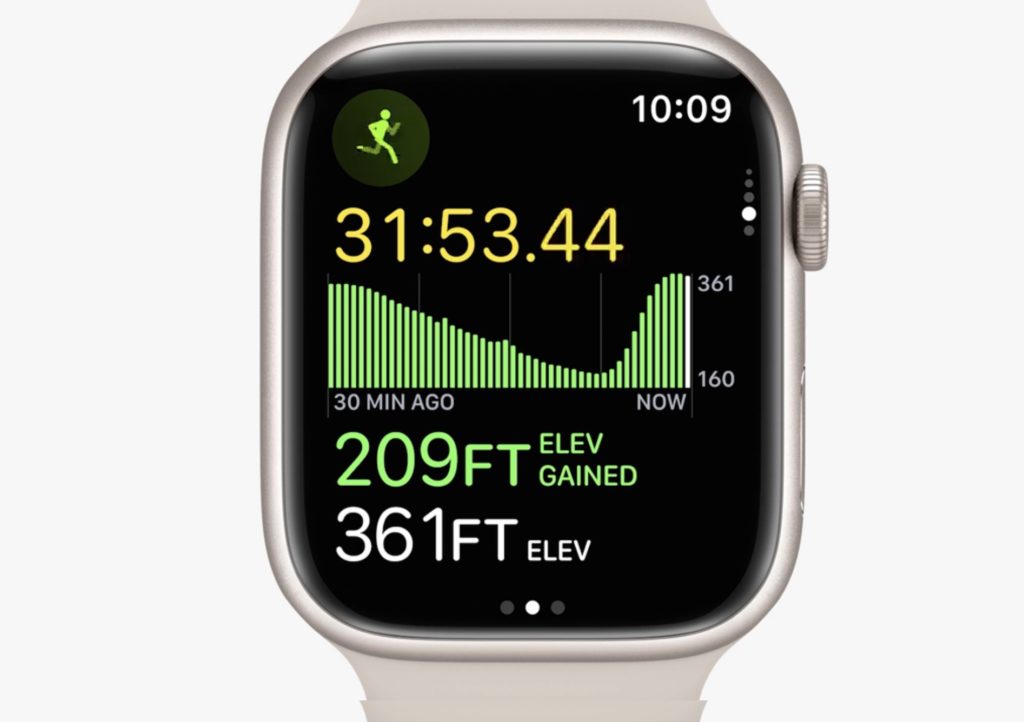
Elevation is a key metric if you want to work on hill work (which is important to do!) and you want to see the over all elevation profile of a run or course. Things like Strava can provide that for you but getting to see this right on the wrist in the Apple Workout app is something which now puts it on par with Garmin.
Of course, it wouldn’t be an Apple move if it didn’t look nice, too. It does have a better looking version of it than Garmin, if you care about those kinds of things.
Heart Rate Zones
This is another area where Apple is finally catching up with Garmin, and it is a very smart addition for Apple to make. There are a lot of runners that train by their heart rate zone as opposed to other metrics like pace. Knowing your heart rate zone at a glance can be key and Apple makes this very easy to see and follow.
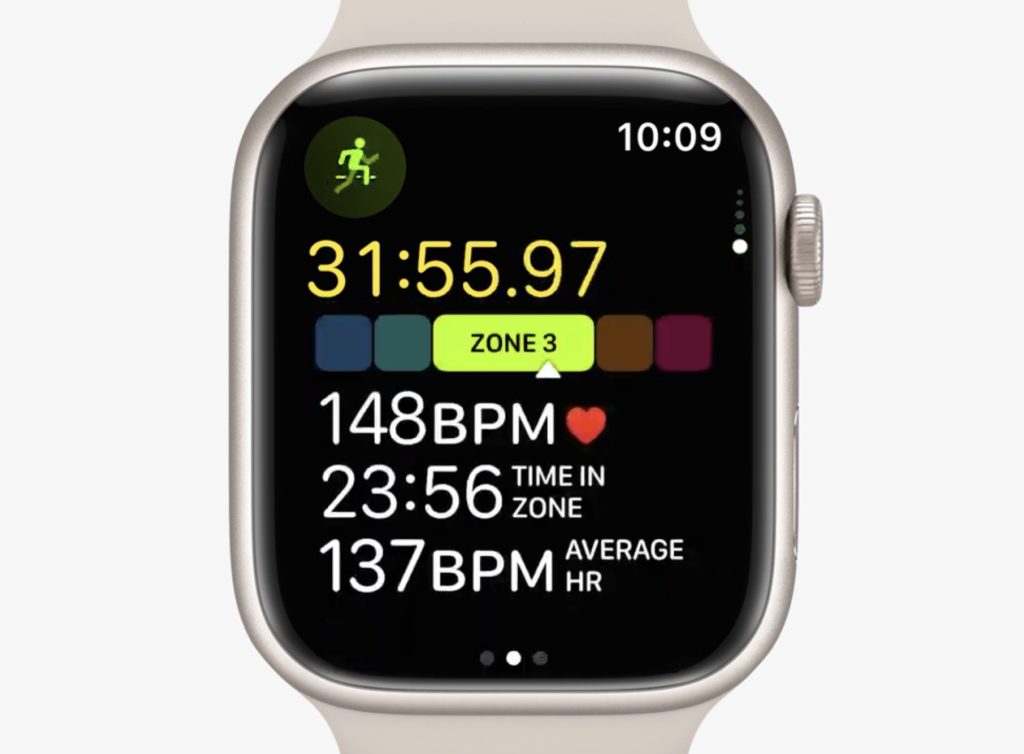
While this just catches up to where Garmin has already been, it is certainly a new feature that may draw some runners back to an Apple Watch due to its usefulness and implementation.
Structured Workouts
A few years ago, for purposes of a review, I did my training and the running of a marathon using an Apple Watch Series 4 (the latest, at the time). I had one giant annoyance and something that I would not do with my Apple Watch. That was running structured workouts. For those that don’t know, this is where you can build into your watch a workout that helps you focus on things like speed. For example, maybe you warm up for 10-15 minutes, and then you do some 800 meter repeats at a certain pace with rest jogs in between and 10-15 minutes of cooldown.
Before now? Absolutely undoable within the Apple Workout app. Sure, there are 3rd party apps, but I wanted to use the Apple app and for my workouts like this, I had to go back to a Garmin (and just used the Apple Watch to track the overall run).
Now, structured workouts are coming so it will be better than ever for the runner that is doing workouts to gain speed or work on something for a race.
Again, this just catches up to where Garmin already is but it is definitely time for it.
Running Power
This is huge! While Garmin has just introduced the running power metric for their watches, natively, they still do not let you track your running power without some other interface. Apple, like COROS, is now going to do running power right on the wrist.
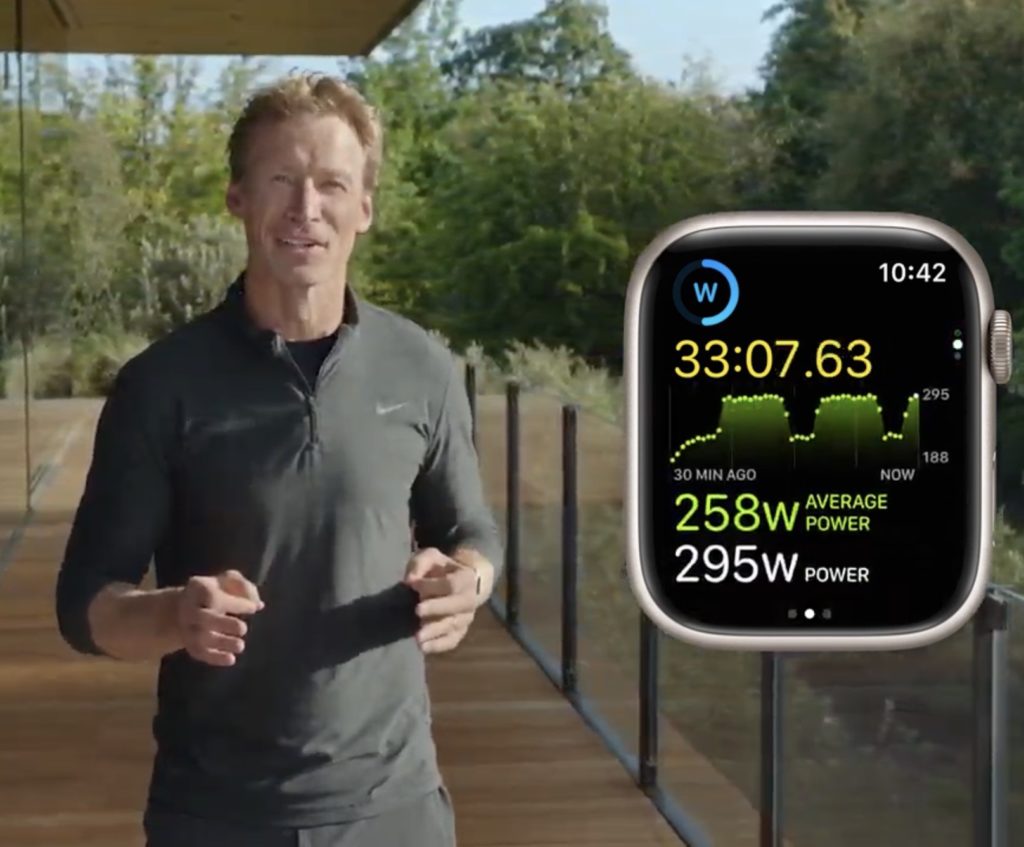
Running power can be a one-stop-shop for training that helps you see your overall performance and improvement rather than checking on pace, heart rate, elevation, etc. Running power shows you effort which is great for someone training in heat. It can be hard to hit your demanding workout paces in high heat so using running power instead can be a way to make sure your body is getting the workout without having to hit the paces.
Apple has passed Garmin with this addition – for now.
Past Courses
If Apple will allow for the downloading of things like marathon courses, this will be a great inclusion as well. For now, it looks like Apple will let you just race yourself on a previous course. If you have a certain route you run often, this is a nice way to check your progress against your past runs.
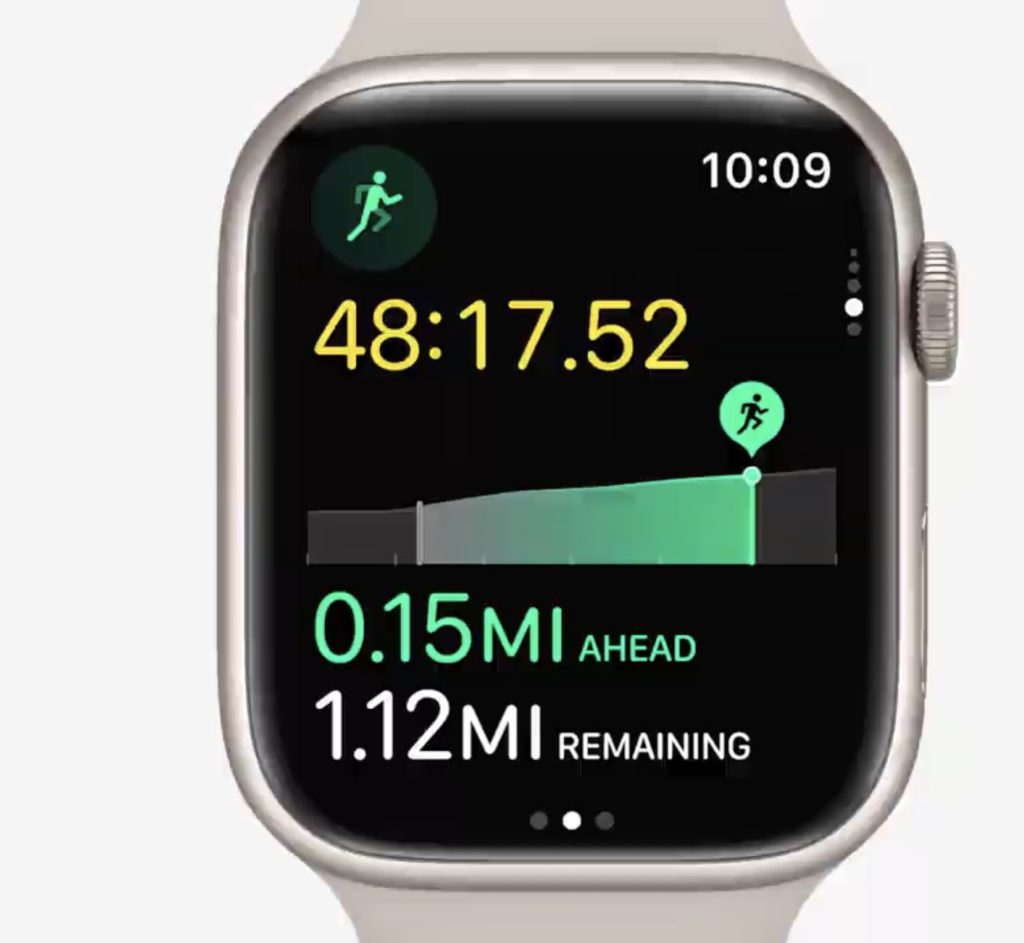
Again, Garmin has had this for a long time and I recently used their PacePro Course creation for the Stockholm Marathon and loved how nicely it works. While it is nice that Apple has brought this, unless they expand it for things like races, Garmin has the edge here.
Automatic Triathlon Tracking
Apple has finally added multi-sport capability in the form of their triathlon switching. Now, Apple will sense the switch in motion for a triathlon and automatically switch the sport from swimming to cycling to running. That finally makes Apple have a leg in the triathlon space – except not for a 70.3 Ironman or a full Ironman due to the battery.
Apple Watch in 2022 Summary
As you can see, there is a lot that Apple is bringing to the Apple Watch this year. I have an old Series 4 that I will be downloading the beta on as soon as I can to see how much of this will work on that model.
Apple is definitely in the running watch game now!
Garmin in 2022 – Apple Watch vs Garmin
Garmin has long been king of running watches with their broad lineup to fit every kind of runner and athlete. Over the years, they have smartly been adding more functions that help it to be an all-day watch with things like smartphone notifications and even cellular linkups.
This year, Garmin has gone bigger than ever. They started the year by introducing their most expensive, mainline watch yet – the Garmin Epix 2. This watch is basically a Fenix 7 but with one Apple-like quality – an AMOLED display. AMOLED displays are great for not just looking prettier and brighter but also being able to show more detailed data.
This means that the Garmin Epix 2 is actually even more useful for mapping than a Fenix 7 due to the amount of resolution it can display. I have a Garmin Epix 2 and can tell you that I don’t think I could go easily back to the MFT display of the rest of Garmin’s watches (with a few exceptions).
Mapping
This year, Garmin did something they have not done before – given worldwide maps to customers. Before, you had the region of maps for the region you bought the watch in – and then you had to purchase other regions from Garmin if you wanted them (unless you wanted the free versions from other suppliers). No more! Now, you get them all and you can download what you want.
The mapping is very helpful for not just seeing where you are going but letting your map-equipped Garmin identify a course for you. I have used this many times in new areas. I tell Garmin I want to do a 8 mile run and then it will give me 3 different options. Once I select one, they do all the navigating and just tell me when to turn!
In the US, it will also tell me what the elevation is like ahead and what kind of grade ascent/descent it is, as well as how long it is. This type of information is great for someone like me who wants to know exactly where he is going. 🙂
Garmin beats Apple with mapping.
Focus on Training
Garmin is still a much better watch for many runners and athletes but they still had a problem with Apple – many people would stick with their older Garmin and buy an Apple Watch. They would use the Garmin for workouts but the Apple Watch was used for all day.
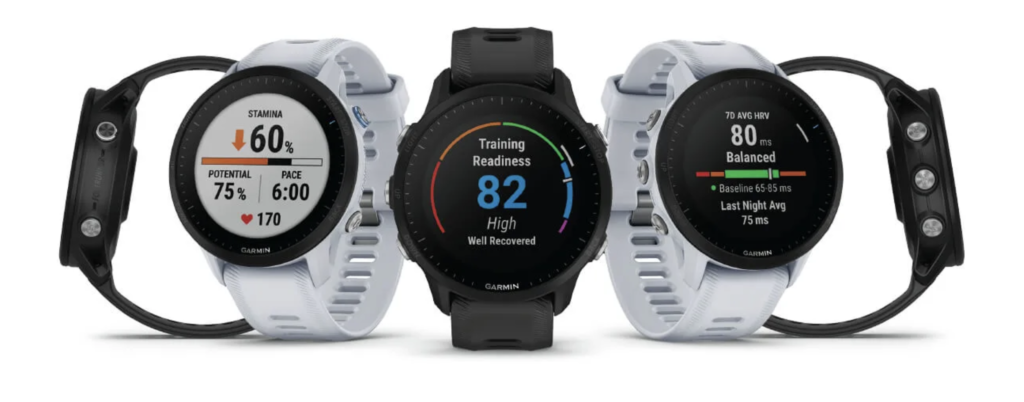
Garmin’s new metrics to help you see your readiness for training
Well, Garmin started addressing this a couple of years ago with a new feature on the Garmin Forerunner 745 that gave you workout suggestions based on your body data.
While this was great and really did help direct training to meet the needs of your body and performances, it was not based as much on things like sleep like it should be to make it even more helpful (I would check the suggested workout at 12:01AM and it would be the same exact suggestion at 7:00AM, regardless of the amount/type of sleep I had between those times). I actually used the Garmin suggested workouts and those alone last year to get ready for a half-marathon, and ended up having my 2nd best half marathon time yet!
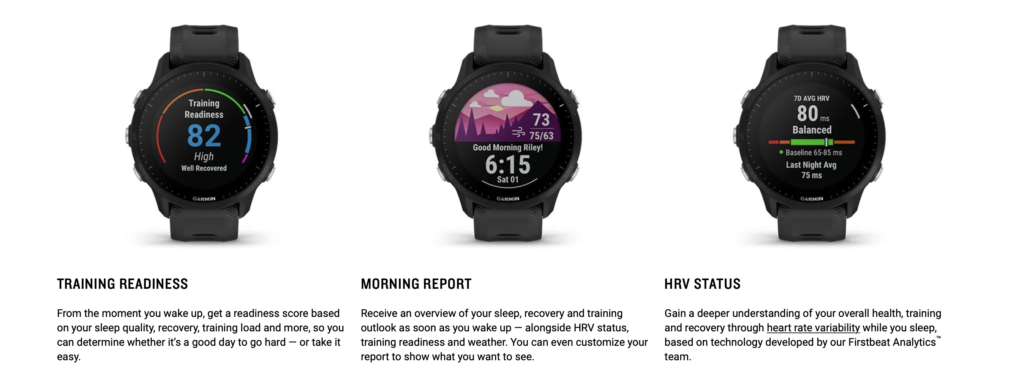
This year, with the Garmin Forerunner 955 and coming soon to the Fenix 7 and Epix lineup, Garmin is making their watches even more relevant for all-day wearing. They have added a new daily readiness metric called “Training Readiness” which will compile numerous metrics (sleep, recovery time, HRV status, Acute Load, and stress) to tell you your readiness for training.
To make this work, you have to wear your Garmin all day to get this data synced up. This makes a huge case for Garmin to have people switch to using it for an everyday watch instead of Apple, if the user is really into keeping track of their body. Plus, with watches like the Epix 2, they are quite stylish as well.
Garmin crushes Apple with training focus points.
Multi-Band Satellite Systems
With the more expensive Fenix 7 models and Epix 2 model and now the Garmin Forerunner 955 and Forerunner 255, Garmin has brought what some consider the holy grail of GPS accuracy. That is multi-band satellite system tracking. This enables the Garmin watches to use several of the available systems, which makes for much more accurate GPS tracks.
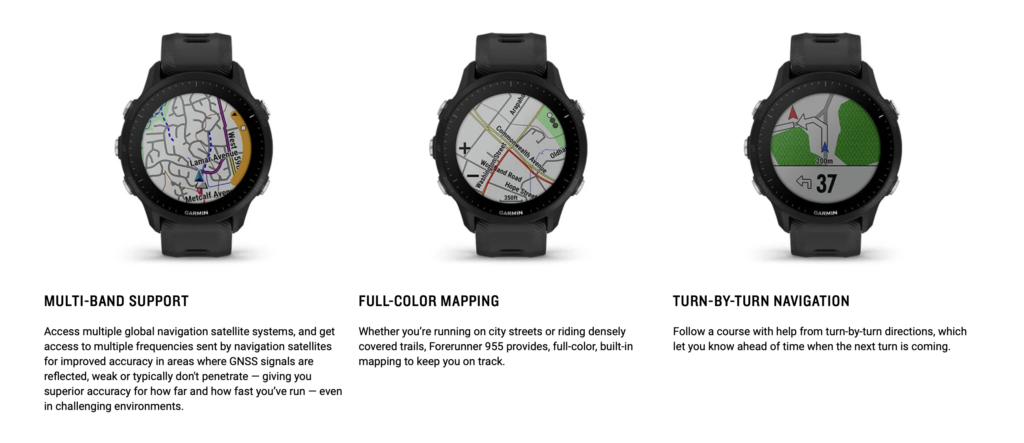
Great GPS system additions to Garmin watches this year
This kind of accuracy will be very noticeable in cities with large buildings and in places like forests or even smaller cities with tiny streets. I have an area in the city that has always been horrible with previous Garmin watches. It is one part of the street where I do a half marathon and my pace starts going nuts – like I will be running around a 7:00 per mile pace and all of a sudden the watch starts telling me I’m doing 11:20 per mile. It would be one thing if this was just for a couple of hundred feet and done but it is more like 1/2 mile and we hit this same section 3 times.
This past year, I ran with the Garmin Fenix 6 and COROS Pace 2 on my wrists and found that the COROS Pace 2 kept much better track of the GPS than the Fenix 6. With my new Epix 2 this year, I ran that same section utilizing the “All Systems + Multi-band” and it was absolutely perfect. I don’t know why I had problems before because there are no high buildings there and no excessive antennas but it was not a problem at all with the new system in the Epix 2/Fenix 7 (only the sapphire models of each) and the new Forerunner 955/255 watches.
This is in contrast to Apple who still sticks with their “Apple-ness” when it comes to GPS tracking. Go to start a workout and you get a countdown from 3-2-1 Go – with no notification of satellite signal acquisition, etc. It will use the physical data and movement at the start and then uses their smoothing after getting a good fix to make it “look good” after. But, it will have problems just like other watches without the all system abilities.
Garmin beats Apple with GPS accuracy and tracking.
Solar

Garmin now has several watches with solar ability – the Fenix 7 (in all size variants), the Instinct 2, the Tactix 7, and the Forerunner 955. This solar capability helps you squeeze out a few more hours of training if you have decent sunlight. This helps the already impressive batteries to last even longer, in the case of the Instinct 2, to last “forever”.
There is no solar-equipped AMOLED watch yet so for now you pick either the “pretty” screen or the solar screen but it is still great to have that option. No such option with Apple…
Garmin beats Apple with solar capability.
Garmin Adds Touchscreen Functionality
Many had wanted touchscreen ability on the Fenix lineup of watches and Forerunners (it had existed on some Garmin watches that were targeted more as lifestyle fitness watches) but many also did not want it. There is something really good about having tactile buttons that let you start, stop, review, change screens, music, etc. over having a touchscreen. Plus, a touchscreen can be very unreliable in certain conditions (like with gloves on, when water hits it, etc).
Well, Garmin did the best of both. They gave touchscreen ability on their new Fenix 7 and Epix 2 watches and brought it to their Forerunner 955 as well. But, you can choose if you want the touchscreen on for workouts (I shut it off then), on for night mode, or off all the time. So, everyone gets the best of both worlds! And, the touchscreen works really well, especially when scrolling through some of the data screens to check things like elevation, heart rate, etc.
Garmin catches up to Apple with a touchscreen.
Apple Watch vs Garmin | Why Apple Will Not Beat Garmin in 2022, Unless…
As you can see, both companies have really positioned themselves well to take on the other. Garmin, with more of their body metrics to help you know when the best days and times are for your training. And Apple with the addition of more Garmin-like qualities to make their Apple Watch an even more serious runner’s watch.
But, Apple will not beat Garmin this year (or any year) if they do not address one thing and that is battery life. Apple would say that they have added more sensors, larger displays, faster processors, and more without having their battery life take a hit. That is true. But, before this year, Apple could comfortably stand on their beautiful AMOLED displays as a reason why the watches have to be charged every day. And they did make sure that the Apple Watch Series 7 charges even faster.
Well, Garmin this year introduced their Epix 2 with its own AMOLED display and it is just fantastic. Not only is it a great display but it also has touchscreen ability that works really well. And the battery life? With gesture mode enabled, I get 15 days of battery life out of it, and that is including about 12 workouts in that time.
If you want the display on all the time, you are still going to get far more time than the Apple Watch will give you. And this is what Apple needs to really step up on if they want to try to beat Garmin. It is not just about having to charge the Apple Watch everyday. It is about the fact that the Apple Watch is limited to certain activities that may take longer than 6 hours to complete. Things like an ultramarathon or a triathlon, which is something Apple added functionality for this year.
But, it sure is nice to see the competition heating up a bit since that helps us, the consumers, to win in the end!
For now, the Garmin Epix 2 will still be my watch of choice. I will be updating an Apple Watch to WatchOS 9 to test out these features but I am so spoiled by the battery life of my Epix and the training help it does and will provide that I don’t want to switch to Apple. For the two-way interaction that the Apple Watch provides, I can always just pull out my phone if I need to do something. But, I’m fine with just getting the notifications on my Garmin.
For 2022, the Apple Watch vs Garmin battle will certainly be fun to watch – and even more fun to take advantage of as runners!
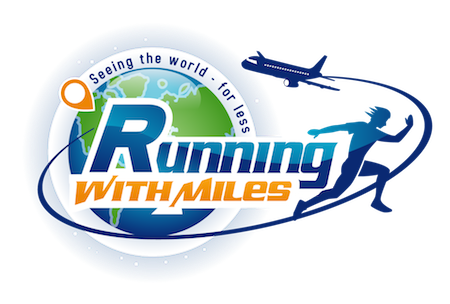








Curious what your thoughts are on the EPIX vs 955 Solar for a marathon runner. The EPIX screen is fantastic, but the lighter weight and smaller profile of the 955 is appealing for 24/7 wear.
Hi, Patrick – I just finished a marathon using my Epix on one wrist and the very lightweight COROS Pace 2 on the other wrist. Since I have been using a Fenix 6 (before the Epix) for a while, I am totally used to the weight and I really do not notice it. To get better HR tracking, it is better to have it snug so I always tighten it one notch during running which makes it not move around at all, making it even less noticeable.
But, if you are used to a lighter watch, I do think it could take a while to get used to it. My recommendation would be to go for the 955 and don’t look at an Epix in real life and you won’t miss the display of that watch. 🙂 I want to try out the 955 and am really curious what my experience will be coming from 6 months of the AMOLED display of the Epix. Beyond just looking great, the data fields and maps have far more resolution which makes for a nicer user experience.
Good luck!